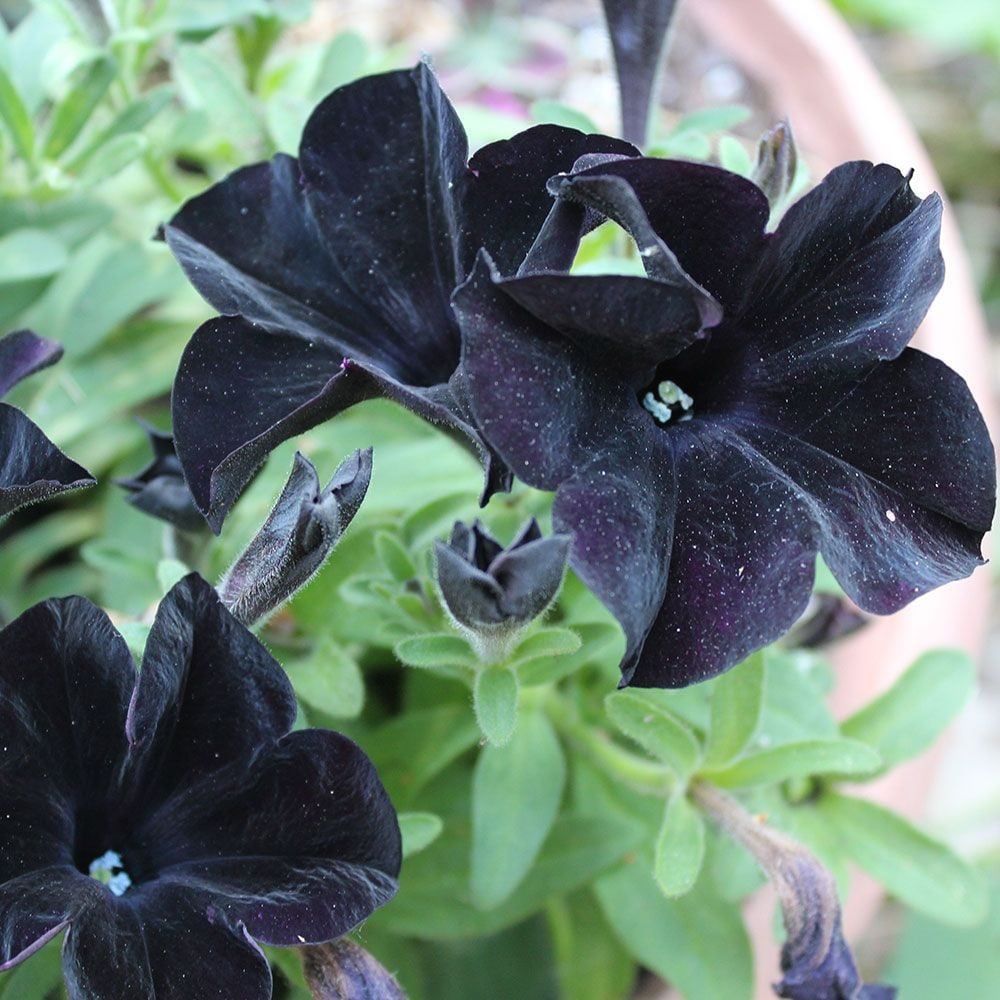
Best Black Plants to Grow
When I first heard about black plants, I didn’t understand what the fuss was all about. Plants and flowers are supposed to be bright and colorful. Why would anyone want dark and dreary black annuals and perennials?
But then I saw my first black petunia—wow! I couldn’t believe how gorgeous and captivating it was. My newfound love didn’t stop with petunias. Once I started looking, I began noticing all kinds of cool plants with dark, rich foliage and blooms. While some were really more like black wannabes, falling into the purple or brown section of the color wheel, I was still impressed with the selection. Take a look at some of my favorites, but be sure to do a little exploring on your own. After all, I hear every garden looks good in black.

Zwartkop Aeonium
(Aeonium arboreum, Zones 9 to 11)
It’s hard to find a more dramatic and impressive black plant than this black rose aeonium. This succulent does best in at least a half day of full sun. If grown in more shade, the rosettes are reddish-purple with a green center. It grows up to 12 inches tall and tolerates drought and poor soil. If you live out of Zone 9 to 11 (and let’s face it, you probably do), then overwinter it indoors!
Why we love it: Though it looks stunning with some bright-yellow petunias or pansies, we think it makes a statement all on its own.
Let your garden take a walk on the wild side with these weird, wonderful plants.

Onyx Odyssey Hellebore
(Helleborus, Zones 4-9)
This double-bloom hellebore actually has three times as many petals as a single-bloom hellebore. Combine that with its amazing velvety flowers, and it’s easy to see why this plant has the horticulture world talking. Onyx Odyssey grows up to 24 inches tall and wide, and is ideal for shade.
Why we love it: It’s an early bloomer! Hellebores start flowering in late winter and continue for several weeks. In fact, it’s also known as Lenten rose, because some varieties bloom during Lent.
These are the best perennials to plant in full sun.
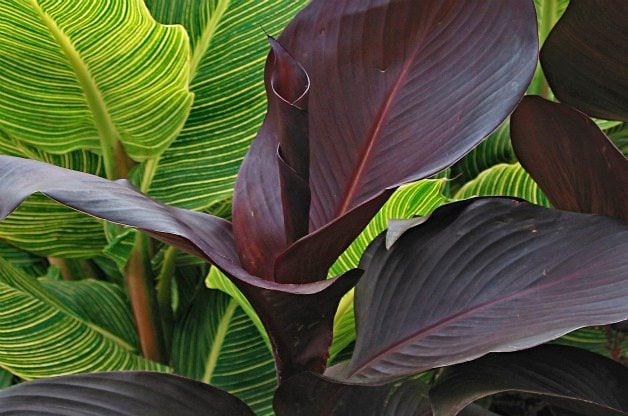
Tropicanna Black Canna
(Canna, Zones 7 to 11)
Boasting bright scarlet blooms, the Tropicanna Black series offers a refreshing alternative for cannas. You’ll need to plant the rhizomes every spring. Then sit back and watch the magic as they grow up to 6 feet tall.
These black plants do best with at least six hours of sun, but will tolerate some shade.
Why we love it: It’s one of the easiest ways to bring the flair of the tropics to your backyard. See our list of the top 10 tropical plants for your garden.
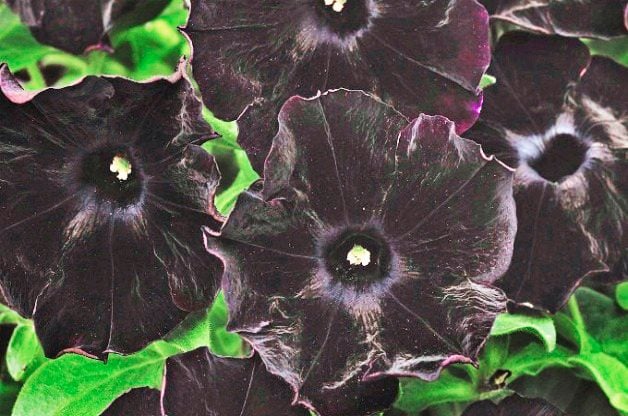
Black Magic Petunia
(Petunia x hybrid, annual)
Are you ready for the world’s blackest petunia? Here it is! Ball Horticulture Co. introduced Black Magic several years ago, and it’s since become one of our favorite black plants. A perfect fit for containers, it thrives in sunny areas.
Why we love it: Containers just got more interesting, thanks to the richness of this plant. Pair it with pink blooms for a lively contrast.
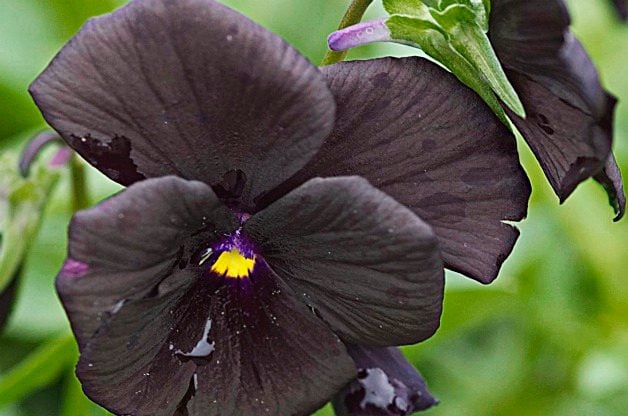
Sorbet Black Delight Viola
(Viola cornuta, annual)
Also known as horned violet, the low-maintenance, fragrant viola tolerates sun and partial shade and blooms most profusely in cool weather. Everyone should grow some violas, so why not try this bold cultivar?
Why we love it: You know how you get that itch to garden even before the chance of frost has passed? Grow this—it’s forgiving.
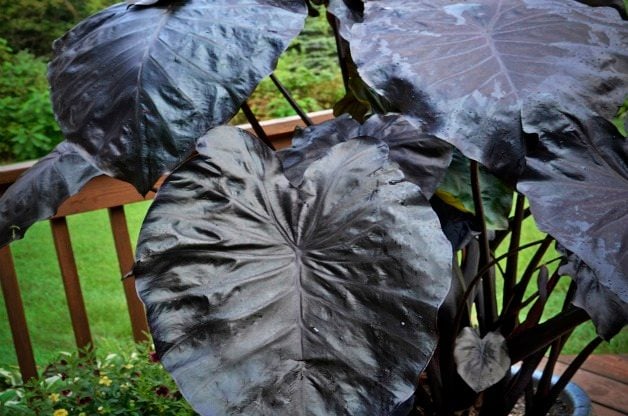
Black Coral Elephant Ear
(Colocasia esculenta, Zones 7-10)
Elephant ear is a plant that already commands attention with its giant leaves. This black-leafed variety is even more striking, growing nearly 4 feet tall with leaves 3 feet or more across! Even if you live in a colder zone, you can enjoy the beauty of Black Coral year after year. Just dig it up and keep it in a cool place over winter.
Why we love it: It’s one of the most distinctive plants for containers, but you’re going to need a big one! Plant it as the centerpiece and accent with bright plants around it.
Check out the top 10 biggest blooms for your flower garden.

Persian Lily
(Fritillaria persica, Zones 5 to 8)
This eye-catching plant is sure to make visitors pause and admire its hundreds of gorgeous dark flowers. When placed in areas with full sun it can grow to be 28 to 32 inches tall and 12 to 18 inches wide, so be sure to give it plenty of space! Persian lily does best in fast-draining soil.
Why we love it: It’s known for its resistance to deer and rabbits, so you won’t have to worry about critters having it as a snack.
Try these pretty white flowers to make your garden glow

Black Magic Mangave
(Mangave, Zones 9 to 11)
A plant created by Walters Gardens for its “Mad About Mangave” collection, the grower explains that Black Magic Mangave is a “intergeneric cross of Manfreda x Agave.” They say it has a fast growth rate and leaves so heavily spotted, they’re almost black. They recommend growing this succulent in full sun to get the best color.
Why we love it: This succulent is a true standout, offering unique color that makes it one of our favorite black plants. Plus, it’s critter-resistant and doesn’t require much water.
Grow these 11 succulents that will attract pollinators.
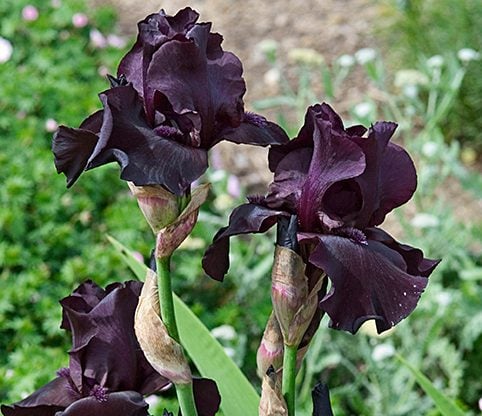
Before the Storm Tall Bearded Iris
(Iris, Zones 3-10)
Irises are a staple in backyard gardens, and they’re available in just about every shade imaginable, including this purplish-black variety. Before the Storm has a bit of a sweet fragrance and blooms in early summer, making it the perfect plant to provide garden color in the lull between tulips and flowering perennials. Like all tall bearded irises, it performs best in full sun.
Why we love it: It’s naturally deer- and rabbit-resistant, so if you have trouble with critters eating your plants, give it a try.
Check out 12 beautiful blue flowers for every garden.
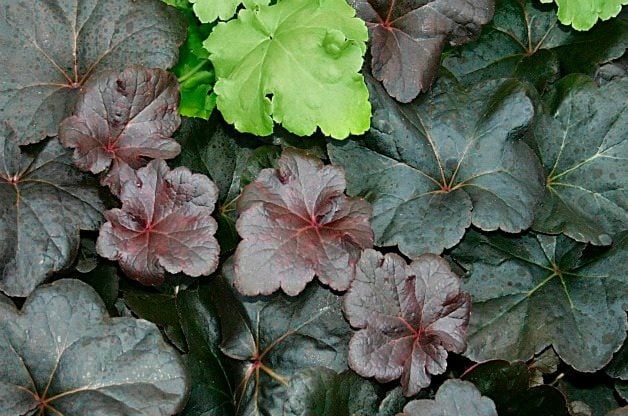
Obsidian Coral Bells
(Heuchera, Zones 3 to 9)
While coral bells do have tiny blooms atop long shoots, many people buy them for the foliage. And why wouldn’t you, with options like deep red, orange and black. This Obsidian cultivar is just one of several coral bells with black leaves.
Why we love it: You can plant coral bells in partial shade. And the tiny blooms attract hummingbirds!

Bring striking sights to any landscape year-round with a mildew-resistant cultivar of native ninebark. It’s perfect for a pollinator garden or any small space where you need a punch of color. Here’s why you should plant a fireside ninebark shrub in your yard.
Grow brandywine viburnum for tie-dye berry clusters.
On This Page
Fireside Ninebark Shrub Care
Before you pick out a spot for this shrub, here are a few key things to know.
- Common name: Fireside ninebark
- Botanical name: Physocarpus opulifolius
- Zones: 3 to 7
- Light needs: Full sun
- Size: 5 to 7 feet tall and 4 to 6 feet wide
Pinkish white bloom clusters appear in spring and red fruits show up in fall. Psst—never plant these invasive shrubs (and what to grow instead!)
But the constantly changing foliage is the true wow factor on this ninebark shrub—its red leaves mature to reddish purple until fall, when they transform to dark purple.
Ninebark Shrub Benefits

Fireside ninebark is versatile and can shine in a number of outdoor settings—use it within mixed borders, as an informal hedge or as a privacy plant. This ninebark pulls double duty in spring with delicate flowers that attract butterflies, while birds such as finches and sparrows nest among the foliage.
More Ninebark Shrub Cultivars to Try

New cultivars with colorful foliage have moved this native plant out of the back border and into the spotlight. Other colorful cultivars to try include Ginger Wine, Little Devil and Amber Jubilee.
Whether you have a small outdoor space or want to brighten up a bare corner, add compact Little Joker ninebark (zones 4 to 8). Pale pink flower clusters on burgundy stems bloom in spring and summer before deep purple foliage with jewel green undertones takes over. It’s also mildew resistant and cold tolerant.
If you’re looking for a shrub with lots of fall and winter interest, go for Tiny Wine ninebark. Mature stems on the deciduous plant peel back to expose red and light brown inner bark. It grows up to 5 feet tall and 4 feet wide, does best in full sun and adapts to most soil types.
Next, check out more beautiful white flowering shrubs.
Sources
Black Swallowtail Butterfly Facts

- Common name: Black swallowtail butterfly
- Wingspan: 2 3/4 to 3 1/4 inches
- Distinctive Markings: Primarily black from above, males have an extra band of yellow dots. Their bodies are also black with rows of yellow dots. On hindwings, blue markings and black-centered orange eyespots
- Habitat: Open areas such as gardens or wetlands
- Caterpillar: Bright green with black bands and yellow or orange dots. The youngest caterpillars are nearly all black with a white back patch and orange spots
- Host Plants: Celery, dill, parsley, sweet fennel and caraway
- Backyard Favorites: Adults sip nectar from red clover, zinnia and thistle
“A black swallowtail (above) sipped nectar from a clover plant at the edge of a pond. I love the colors in this photo, along with the crisp image. It was a beautiful day to watch nature unfold,” says Birds & Blooms reader Nancy Melton.
Meet 6 common swallowtail butterflies you should know.
Eggs and Host Plants
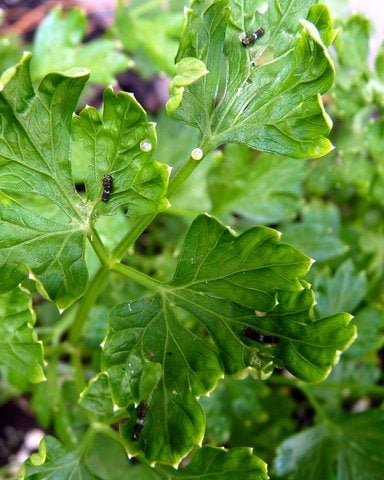
I saw my first black swallowtail butterfly the other day, and it immediately sent me running to my parsley bed to see if the butterfly had laid any eggs. You see, most people grow herbs for cooking, but I tend to grow them mostly as host plants for butterflies.

Black swallowtail butterflies (Papilio polyxenes) lay eggs on celery, sweet fennel, caraway, parsley and dill, along with common roadside wildflowers like Queen Anne’s lace. This is one of the easiest butterflies to lure to your own backyard, just by planting a bed of these herbs in a sunny spot. The eggs are lovely little yellow orbs, very easy to spot on the herb leaves.
Discover fascinating swallowtail butterfly facts.
Black Swallowtail Caterpillars

The eggs hatch into tiny black caterpillars with a white stripe across the middle. As they grow, the caterpillars become mostly green with black bands and yellow markings. Some people call them parsley caterpillars.
The caterpillars of this species undergo many changes before they’re ready to pupate. These different phases are called “instars.” The process takes about two weeks from egg to chrysalis.

A black swallowtail spends the winter as a chrysalis (remember, butterflies form a chrysalis, while moths form a cocoon). It contains a chemical that acts as antifreeze so it can survive cold temps. Then it emerges as an adult come spring, and it’s always worth the wait.
Here’s how to plant a caterpillar cafe in your butterfly garden.
Where to Find Black Swallowtail Butterflies

Black swallowtails are found throughout much of the U.S., including east of the Rocky Mountains and parts of the Southwest. They closely resemble a common Southeastern species, the spicebush swallowtail. Although they fly all summer long, in the deep south the herbs they use as host plants may struggle to grow in the summer heat. Try keeping the herbs in partial shade and watering frequently to keep them alive and encourage black swallowtails to visit.
“This bold black butterfly (above) felt special to me because it was one of the first I spotted that spring,” says Birds & Blooms reader Linda Carissimi. “I like how the swallowtail posed with its wings open on the clematis.”
Next, learn how to identify and attract a giant swallowtail butterfly and a zebra swallowtail butterfly.
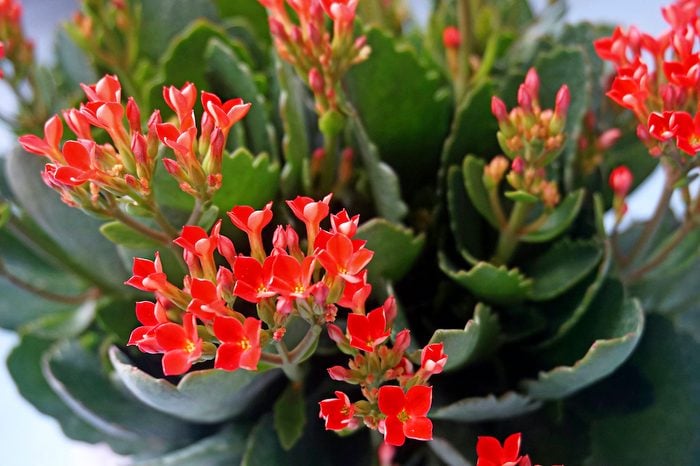
Kalanchoe is popular with gardeners for a variety of reasons. Houseplant growers enjoy this succulent for its long-lasting brilliant red, pink, orange or white bloom heads that appear above the waxy green leaves in the cold of winter. That’s when we need colorful flowers the most! Those in warmer climates appreciate its drought-tolerance, making it great in rock gardens and xeriscaping. Growing kalanchoe is pretty easy, but there are a few tips that will make it even easier. Here’s what you need to know before you grow this plant.
Kalanchoe Pronunciation and Plant History
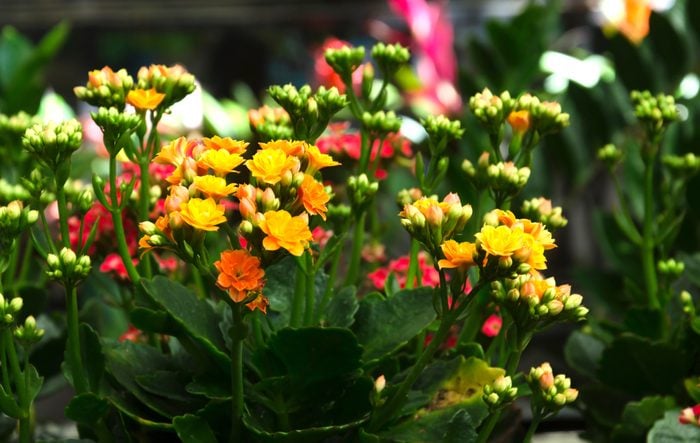
First up: How to pronounce this troublesome plant name! The Botanary at Dave’s Garden says it’s “kal-un-KOH-ee,” and also notes that the name comes from the Chinese for one of the species.
There are over 125 species in this genus, but the one you’re most likely to come across in grocery store florist departments or houseplant nurseries is Kalanchoe blossfeldiana. It’s native to Madagascar and was brought to the rest of the world in 1932 by the botanist Robert Blossfeld. Due to its extreme cold sensitivity, kalanchoe is best-suited as a houseplant in most climates and has become a very popular one.
Learn how to grow and care for Haworthia succulents.
Kalanchoe Care

- Botanical name: Kalanchoe blossfeldiana
- Zones: 10-12
- Light needs: Full sun, as well as 14 hours of darkness for re-blooming
- Soil: Well draining
Kalanchoe is fairly easy to grow indoors when placed in the right conditions. It grows 12 inches wide by 18 inches tall and needs a temperature of between 60 – 85 degrees F. Low humidity and four hours of direct sunlight — as well as 14 hours of darkness for 6 to 11 weeks — are musts, too. Be sure to place it in well-draining soil; over-watering or letting it sit in wet soil can cause root rot. Like other succulents, an occasional, thorough watering is all it requires.
The plants are usually sold in the winter or early spring, while in their natural bloom cycle. The flowers are long-lasting, but once they fade, you can trim the heads to better enjoy the succulent foliage. Lots of bright sunlight will keep this plant healthy throughout the summer months, whether it’s growing indoors or out.
Kalanchoe is fun to share with friends, as it grows well from cuttings and sometimes even sets new buds on the edges of the leaves. With the wide array of kalanchoe colors and flowers available, you can start a collection of free plants in no time at all.
We found 12 perfectly pink succulents for your home.
Help the Flowers Re-Bloom
One of the more challenging parts of growing kalanchoe can be getting it to re-bloom. Kalanchoe is what’s known as a short-day plant, meaning it needs extended periods of complete darkness to form buds. (Poinsettias and Christmas cactus are also short-day plants.) If you’re growing it outdoors (in zones 10 to 12), the natural day-night cycle will take care of this for you. Look for buds to start forming in winter and early spring.
When growing kalanchoe as a houseplant, you may have to help it along. If the room where you keep it experiences a lot of artificial light in the evenings, change the location to allow a more natural light cycle in the fall, until the buds appear.
Next, discover 7 surprising facts about succulents.

Pileated woodpeckers are large, graceful birds, and may be easier to attract than you thought. As big as a crow, the pileated woodpecker is the largest member of the woodpecker family in North America. Its name comes from the Latin word pileatus, which means “capped,” alluding to the bird’s conspicuous crest. Here’s all you need to know about these gorgeous red crowned woodpeckers.
Is the ivory-billed woodpecker related to the pileated woodpecker?
Males and Female Pileated Woodpecker

Pileated woodpeckers are big, bold and beautiful, sporting a flaming red crest, black wings and tail, expansive white underwings, and black and white stripes on the face and neck. Males show off an extra pop of red on each cheek known as a “mustache mark.” Females have less red on their face (their mustache is black), but still sport a bright red crest. The male’s crest extends to the top of the bill.
Learn how to identify a hairy woodpecker.
Pileated Woodpecker Size
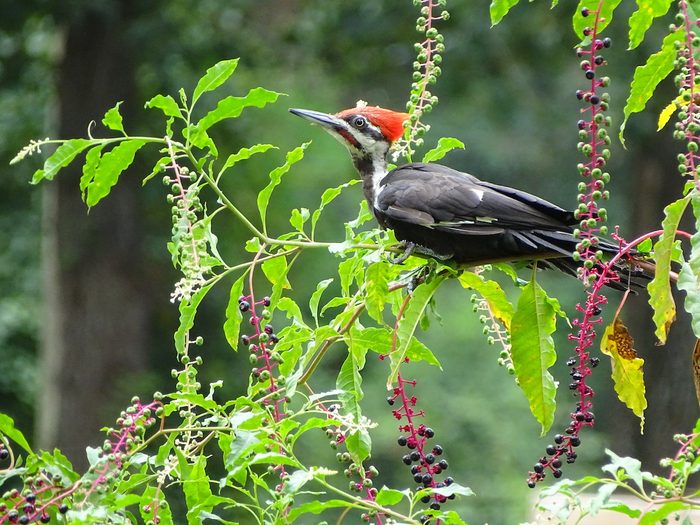
You won’t mistake this bird for a small downy woodpecker. This 16-to-19-inch-long bird is the largest woodpecker in North America. Their wingspan measures 29 inches. The ivory-billed woodpecker was larger, but is now considered extinct.
Meet the red headed woodpecker: redheads of the bird world.
Pileated Woodpecker Nest and Eggs

The mated pair creates a tree cavity. Using no nesting material, the female lays three to five white eggs. You can draw them in with the proper nesting habitat. Attract a breeding duo by leaving dead trees standing or by securing a substantially sized nest box to a living tree. Whether you buy a nest box or build your own, just make sure it’s 24 inches deep and about a foot wide and tall, with a 4-inch entry hole, and hang it 15 to 20 feet above ground.
Learn all about red bellied woodpeckers.
Do Pileated Woodpeckers Mate for Life?
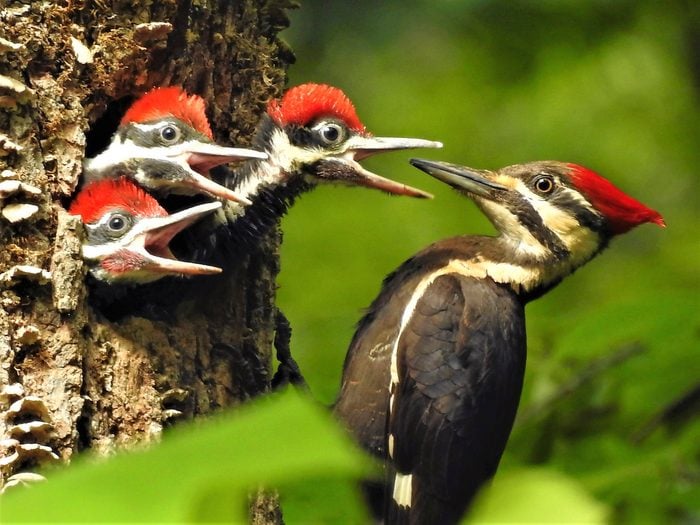
Male pileated woodpeckers kick off their courtship with a dance that includes bowing, scraping and stepping sideways in a circle around potential mates. When paired, they typically mate for life.
Learn about sapsucker birds: woodpeckers with a sweet tooth.
Juvenile Pileated Woodpeckers

Question: Is it normal to see three pileated woodpeckers together? —Libba Fairleigh of Black Mountain, North Carolina
Kenn and Kimberly Kaufman: Seeing two pileated woodpeckers together is normal, because mated pairs often stay together on their territory all year. But it’s much more unusual to see three together. A few circumstances could explain this uncommon sighting, depending on the time of the year. In late summer or early fall, young pileated woodpeckers that hatched during the breeding season may still be associating with their parents. During winter, adults may be less defensive of their territory, so they sometimes allow intruders to linger.
“My husband and I have several bird feeders in our Rochester, Minnesota, yard, one of which is designed specifically for pileated woodpeckers. We have had a pair coming to our feeder for years now. Once their young fledge, the parents bring them to the feeder. The fledgling (above) will fly to a nearby oak tree and wait for the parent to bring suet to them from our feeder,” says Glenda Mueller.
What Do Pileated Woodpeckers Eat?
Their diet mostly consists of carpenter ants, as well as other insects, wild berries and acorns. At home in mature forests, pileated woodpeckers thrive when surrounded by dead trees and downed logs. They’re known for drilling large rectangular holes into tree trunks and thick branches as they search for wood-boring beetle larvae, carpenter ants, termites and more. They have long barbed tongues designed for scooping bugs out of trees. Once carved, the holes offer shelter to owls, swifts, ducks, bats and pine martens.
Check out the 4 best foods for attracting woodpeckers.
Do Pileated Woodpeckers Visit Bird Feeders?
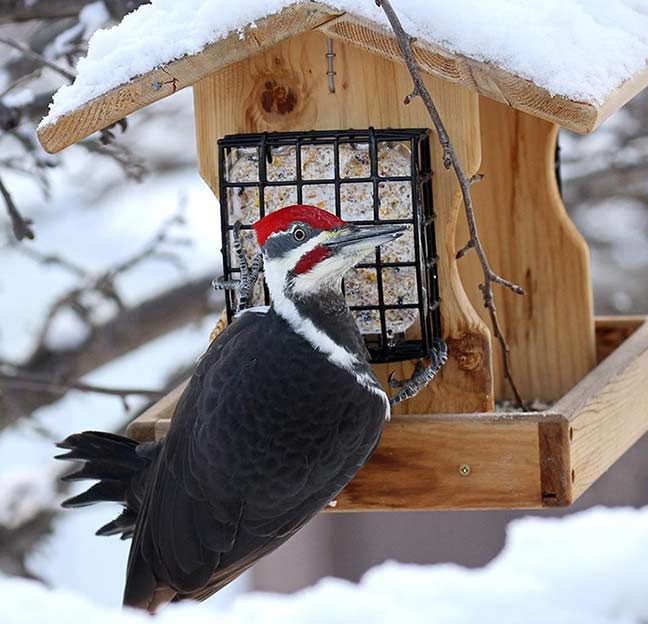
Question: I have a pileated woodpecker that comes to my suet feeder daily. I’ve never seen a pileated woodpecker at a feeder before now. Is this common? —Elaine Eikenberry of Spring Lake, Michigan
Kenn and Kimberly Kaufman: To have North America’s largest woodpecker visiting your feeders on a daily basis is very special, so congratulations! Generally speaking, pileated woodpeckers are wary and elusive, and in most places they do not make a habit of visiting bird feeders. In areas where they’re more abundant, these magnificent birds are gradually becoming more acclimated to the presence of humans, losing some of their wariness and becoming easier to see. A few have even discovered the benefits of bird feeders, but this is still an uncommon sight.
To attract pileated woodpeckers to feeders, set out suet, a high-calorie snack, in a bird feeder that’s large enough for these big woodpeckers. Choose a feeder with a long tail prop. Here are some of our favorite suet feeders and homemade suet recipes.
How These Big Birds Fly

When in the air, the species “has this distinctive undulating flight where they flap, flap, flap, then drop,” says Keith Barker, a bird researcher and curator of genetic resources at the Bell Museum of Natural History at the University of Minnesota. “If you see something basically as big as a crow but flying that way, then it’s this woodpecker.”
Learn about acorn woodpeckers: ultimate stockpilers.
Pileated Woodpecker Call and Sound
Pileated woodpeckers produce deep loud cuk, cuk or wuk, wuk sounds and a long series of high, clear piping calls. Their territorial call is a higher-pitched cackle, “flick-a, flick-a, flick-a.”If one is nearby, you’ll know it!
Listen to the pileated woodpecker’s song.
Bird songs provided by the Cornell Lab of Ornithology.
Range Map and Habitat
Pileated woodpeckers are spotted year-round throughout the eastern half of the United States and along the West Coast. They prefer mature coniferous and deciduous forests and large tracts of mixed woodlands.“We often associate their decline with old-growth forests being cut down, which they are very dependent on,” says Sushma Reddy, curator of birds at the Bell Museum of Natural History. “If there’s a wooded area where people can leave dead branches on the ground, this supports biodiversity and may help to attract more birds.”
Pileated woodpeckers can be drawn to yards. They might roost or nest in dead or dying trees on your property, as well as empty nest boxes. Populations of this species have declined in the past. But luckily, the North American Breeding Bird Survey found a steady increase between 1966 and 2014.
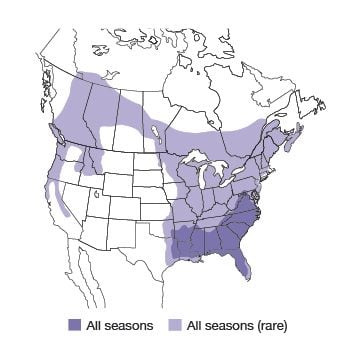
Range maps provided by Kaufman Field Guides, the official field guide of Birds & Blooms.
Next, meet northern flickers: unique, beautiful woodpeckers.
Birds With Imperfect Plumage
Observe birds coming and going through a backyard long enough, and eventually you’ll spot one that has partially white or all-white feathers where there should be color. These birds have a genetic condition known as leucism or, more rarely, albinism, which affects their coloring as well as their ability to survive in the wild. In fact, there are four rare genetic traits that affect feather colors. The next time you spot one of these fascinating flyers, you’ll know how to tell if it’s a leucistic bird or an albino bird.
Backyard tip: Identify birds with odd plumage by their body and bill shape, as well as the other birds in the flock.
Albino Bird
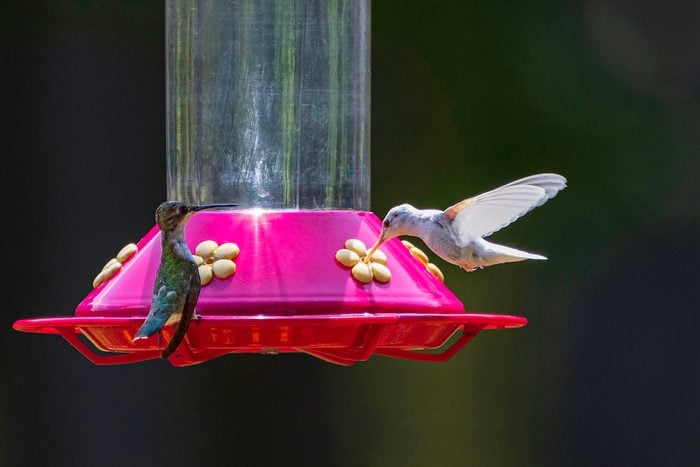
An albino bird lacks all of the color pigment melanin. It sports completely white plumage and is usually devoid of any regular field marks, making it tricky to identify. The genetic mutation is called albinism. Look past its feathers to tell if it’s a true albino—the eyes, beak and legs are always red or pink. The lack of melanin allows blood vessels to show through.
Rare leucistic and albino hummingbirds dazzle bird-watchers.
Leucistic Bird
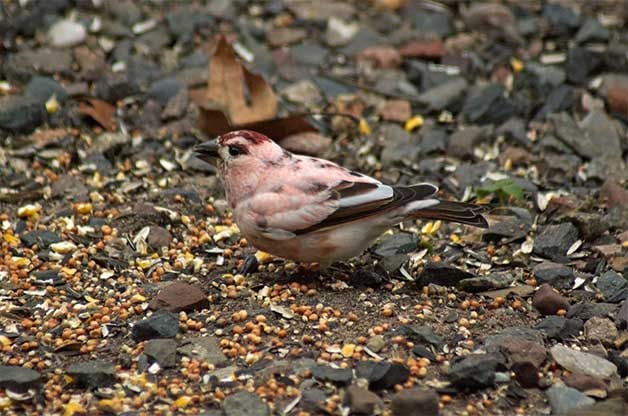
A lesser-known genetic condition is called leucism. Unlike albinism, leucism doesn’t completely eliminate pigment. Leucistic birds have incredibly varied patterns. They may appear more muted than their counterparts or they can be dotted with white patches. These birds are occasionally mistaken for albinos, but leucistic birds always have some pigment in their feathers or other body parts, such as their feet, eyes or beak.
Check out photos of white cardinals and other leucistic birds.
Melanistic Bird

On the other end of the color spectrum is a very rare genetic condition called melanism, in which a bird has extra melanin pigmentation. Most animals—including humans—produce melanin, which pigments hair, skin and more. In birds, it’s responsible for black, brown and tan feathers. When a bird is melanistic, it will appear much darker than the typical coloration for their species.
Is this white bird an albino crow?
Xanthochroic Bird

If a bird is yellow or orange where red feathers should be, it could have xanthochroism. Unlike the other conditions covered here, this one can be caused by diet or genetics. It’s more obvious in birds with lots of red plumage, including cardinals and male house finches.
Check out more photos of rare yellow cardinals.
Effects of Albinism in Birds
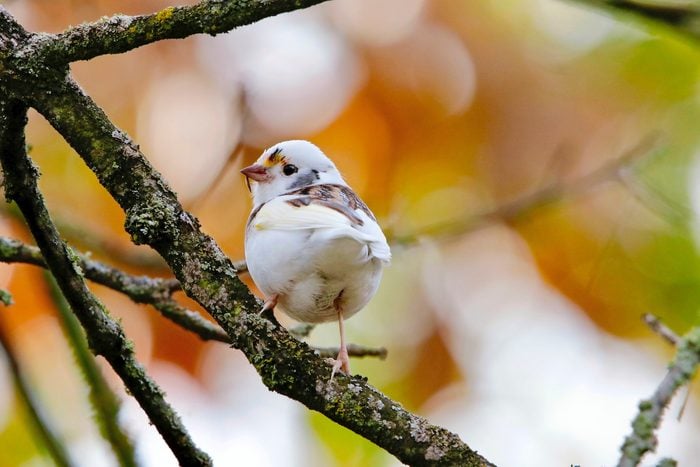
Albino birds are at a great disadvantage because their white feathers stand out against vegetation. Without camouflage, albino birds are easier for predators to spot. Their feathers do offer some protection in snow, but unfortunately they also reduce a bird’s ability to retain heat. Dark colors absorb heat, light colors reflect it, which can mean life or death in freezing temperatures.
Additionally, albino birds suffer from weak feathers due to a lack of melanin. Their feathers break and deteriorate over time. Albino birds also have poor eyesight—another hindrance to survival. As a result, these birds rarely survive past fledging.
Leucistic birds have slightly better chances because they retain some pigmentation. That means a light-colored bird you see in your yard is more likely leucistic than albino. Either way, it’s a rare and exciting sight when such a unique bird stops for a visit!
Question: There is an albino sparrow in my backyard. I’ve read albino birds have poor eyesight and are easy targets for predators. What can I do to help it? —Barbara Stone of Grosse Pointe Farms, Michigan
Kenn and Kimberly Kaufman: If the white sparrow is a true albino with pink eyes, it probably does have poor eyesight. But if it has dark eyes, it’s likely leucistic, meaning that although it may lack pigment in its feathers, it can still see just fine. Despite its coloring, the sparrow could possibly live a long time. Not much can be done to help a bird like this beyond providing food, water and shelter. Roaming house cats are its most likely predators, so keep them indoors.
Five Facts About Discoloration in Birds
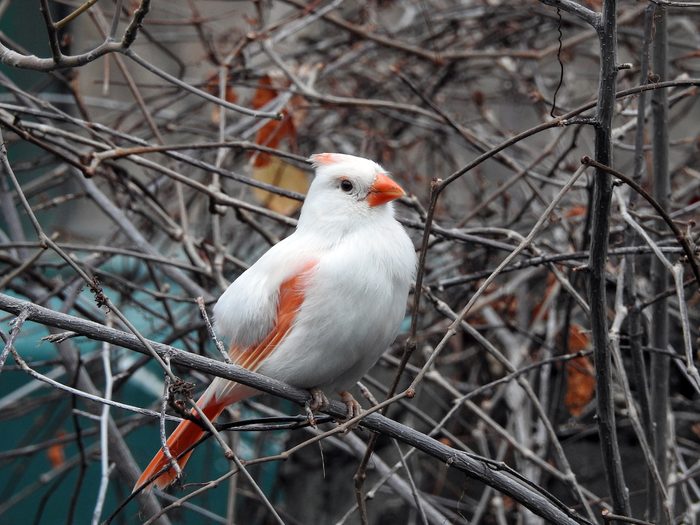
- Genetics determine true albino birds: Both parents have to carry the uncommon recessive genes that produce rare pure white offspring.
- A pied or piebald bird’s leucistic feathers are rarely in a symmetrical pattern.
- Typically, leucism affects only dark feathers, so some birds with leucism have white feathers while still maintaining the bright colors of their red, orange, or yellow feathers.
- A bird is a true albino if its feet, legs, bill, and eyes are pale pink or red.
- Birds with discoloration may struggle during courtship. Many birds use plumage color as a way to find and recognize potential mates.
Pollinators and Birds Love Buttonbush

Buttonbush’s fragrant white flowers are a favorite of bees, butterflies and other pollinators, and well-loved by gardeners. “This is one I think more people should be growing,” says Dan Scott, the former associate director of gardens and facilities at the American Horticultural Society. “Buttonbush presents an incredible white pincushion-esque flower in midsummer.”
Once it starts flowering, this long-blooming plant provides months and months of enjoyment for gardeners and pollinators alike.
Buttonbush’s white spheres are actually made up of tons of smaller flowers that pollinators love. You might see butterflies, hummingbirds and bees stop by the aromatic flowers. Pollinators rely on nectar from the white blooms and, in turn, these pollinators spread pollen from flower to flower.
As the flowers fade, spherical fruits appear and persist through winter, providing seeds for a variety of birds. Ducks and shorebirds are especially fond of the seeds and songbirds may take cover in the large shrub.
See 8 more super fragrant plants that pollinators love. Plus, check out these 11 succulents that will bring pollinators to your yard.
Host Plant for Butterflies
Buttonbush also supports several types of caterpillars as a host plant. A host plant is a tree, flower or shrub that caterpillars hatch on and eat.
These shrubs may attract garden moths like the hydrangea sphinx, titan sphinx or the royal walnut moth. You may spot the adults fluttering around the plants or the caterpillars on the leaves.
Check out the top 10 trees and shrubs with berries for birds.
How to Grow Buttonbush
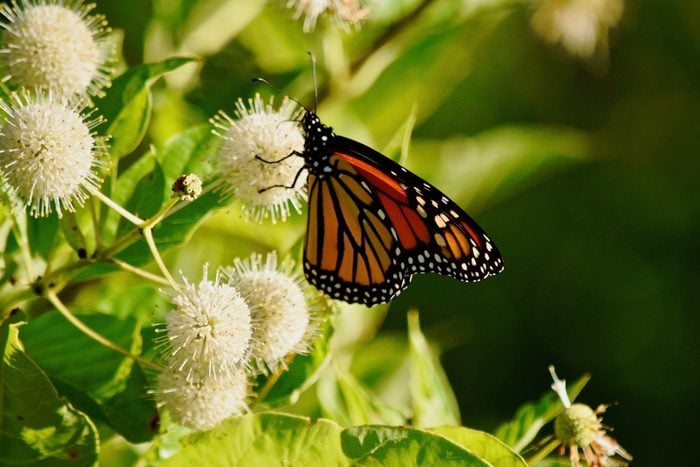
Here’s what you need to know about buttonbush before you plant one of these flowering bushes in your yard.
- Botanical name: Cephalanthus occidentalis
- Zone: 4 to 8
- Light: Full to part sun
- Soil: Moist soil
- Size: More than 6 feet wide and tall, may grow closer to 12 feet in the ideal conditions
When you’re ready to start growing, learn how to plant a shrub.
Where to Plant Buttonbush

Many plants need a spot with well-draining soil and plenty of sun, but not buttonbush. You do want to avoid planting it in a dry area.
In the wild, this plant grows in wetlands and lowlands. So pick a spot that is consistently damp and partly shaded. Be sure to give it room to grow—in the right conditions, it can spread up to 12 feet tall and wide.
For a smaller-space option, consider Fiber Optics buttonbush. Smaller than traditional buttonbush at 5 to 6 feet tall and wide, Fiber Optics is still a true wildlife magnet. Bees, hummingbirds and butterflies will sip nectar from the white spherical blooms. If planted near water, ducks and loons may eat the seeds in the winter. It requires the same general growing conditions as regular buttonbush, and its bright green leaves turn yellow in fall.
Check out the top 10 shrubs for shade gardens.
Where to Buy Buttonbush

Buttonbush is relatively common, so you may be able to buy one from your local nursery. Call ahead to see if they offer the plant or would order it for you. If you can’t find it locally, Nature Hills Nursery offers common buttonbush on their website.
Where to Buy Dwarf Buttonbush
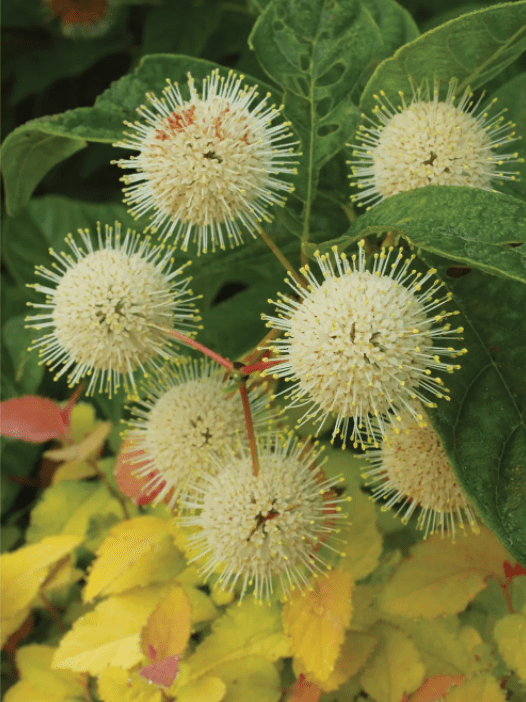
Love the look of this plant but don’t have the space to grow it? Consider Sugar Shack, available online from Burpee. At only 3 to 4 feet tall, this dwarf flowering shrub will fit nearly anywhere.

Many backyard birders grow concerned when another species swoops into their bluebird boxes. A closer look at who’s moving in is warranted, since invasive species like house sparrows can harm and even kill bluebirds. But not all non-bluebird residents mean trouble! A lovely tree swallow will use a bird house meant for bluebirds.
Meet 8 types of swallow birds you should know. Plus, learn about the significance of swallow sightings.
Tree Swallows Use Bird Houses

The tree swallow is a native bird species that builds its nests in the same type of birdhouse bluebirds use. Their range stretches through the northern and upper western United States, as well as most of Canada, during the summer months. These uniquely colored birds are extremely fun to watch as they swoop and swerve, chasing after insects. You should be delighted if they move into your bluebird box!
“I was so disappointed that a tree swallow family took over my bluebird nesting box (above) but I could not chase them away. So I decided to enjoy this family! By the end of June, the little ones were very anxious to be fed! I love be able to enjoy nature up close and personal in my backyard,” says Carol Pedersen.
Baby swallows are too cute — here are 16 super sweet photos of them.
Tree swallows are cavity nesters. They’ll build nests in holes woodpeckers leave in trees, but they’ll also use bluebird boxes if available. The female builds her nest out of grass, needles and feathers, and she’ll lay up to eight white eggs.
Discover fascinating barn swallow facts.
How Can I Help the Bluebirds?
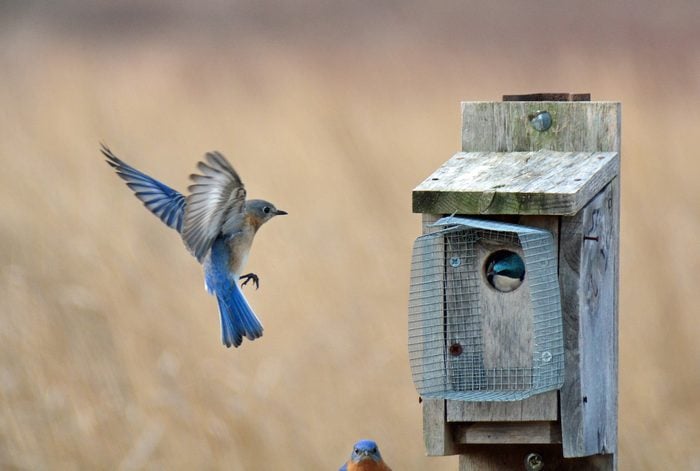
If you’re concerned your favorite bluebirds won’t nest in your yard with the bluebird box taken by a tree swallow family, here’s a potential solution. If you have enough space for it, consider putting up two nest boxes. Just make sure to monitor both boxes so invasive bird species don’t get in.
Even if you’re disappointed not to have nesting bluebirds, you cannot remove a swallow nest from the house. Unlike house sparrows, swallows are native birds and their nests are protected under the Migratory Bird Treaty Act of 1918. But we don’t think there’s reason to be upset. Swallows are exciting, gorgeous birds, and any bird lover would be lucky to have them in their yard.
What does it mean when you see a bluebird?
Swallow Bird House Options

Hang up a birdhouse on a sturdy poll in an open area if you’re interested in bringing nesting tree swallows to your yard. Most of these houses also work for bluebirds and other cavity-nesting birds. So just as there’s no guarantee your bluebird box won’t get a swallow, there’s no guarantee your swallow bird house won’t attract a bluebird! We like this attractive wooden house available from Etsy, which is made with reclaimed materials.

Also consider this cedar birdhouse from Wild Wings that will work for both species. It includes a predator guard and the front door opens wide for easy cleaning.
Offer Several Birdhouses

To attract nesting birds, set up several birdhouses throughout your yard. Be sure to use different-size entrance holes so different species of birds, such as wrens and woodpeckers, can find a house to use. —Gary Clark, Knowlton, Quebec
Learn how long baby birds stay in the nest and more nest facts.
Choose Birdhouses That Attract Multiple Species

Chickadees and wrens use the same kind of birdhouse. If it says “wren house,” it’ll work for both species. —Rob Ripma
Learn how to attract owls to nest in your yard.
Attract Friendly Nesting Neighbors
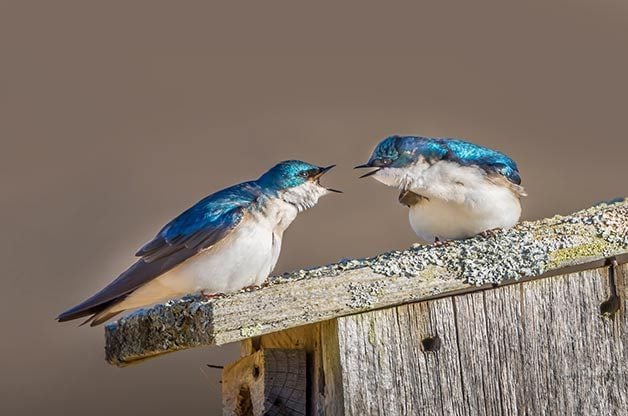
Many species of birds will not nest next to each other. But bluebirds and tree swallows are a different story. I place two bluebird houses 15 feet away from each other. That way bluebirds get one nest box and tree swallows often willingly inhabit the other. They coexist harmoniously, yet other bully birds like house sparrows stay away. —Shirley Barribeau, Goodman, Wisconsin
Find out the best place to put a bluebird house.
Hang Up Baskets

We’ve increased the number of house finches nesting in our yard by wiring small strawberry baskets in the corners of the awnings on our house. We put up four baskets one year and watched 38 house finch fledge from the nests. During winter, some finches even roost in them. —Doris Bartel, Hillsboro, Kansas
Robins often nest in the woven baskets we mount outside. Turn the baskets on their sides and attach them to a wall with a few screws. Mount them under an overhang to protect the birds from the elements. —Connie Moore Medway, Ohio
Will a robin use a bird house?
Add a Bird Bath and Bushes
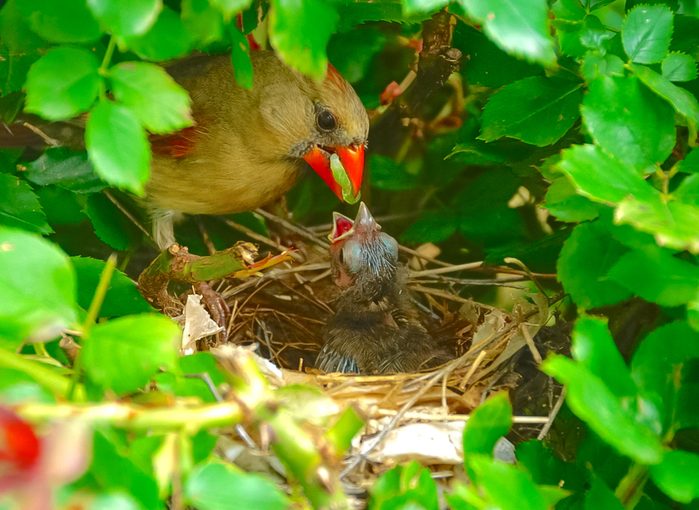
The secret to attracting lots of nesting birds is offering a variety of plants. Grow different kinds of flowers, berry bushes and trees, and keep your bird bath sparkling clean. —Audrey Anderson Boyceville, Wisconsin
Cardinals like to nest in low shrubs and bushes. Check out proven ways to attract cardinals.
Try Birdhouse Gourds

Paint purple martin gourd birdhouses white because it reflects the sun’s rays and keeps the houses cooler. I also place the entrance holes in different locations in each gourd so the purple martins can determine which house is theirs. —Victor Stoll, Finger, Tennessee
Be a good bird landlord with a purple martin house.
Keep Nest Boxes Clean

Because bluebirds build new nests for each brood, clean out the old one after the young leave. This encourages a second and third nest in the same house during a single nesting season. —Bernice Maddux, Weatherford, Texas
Check out super cute photos of baby birds you need to see. Plus, learn about what baby birds eat.
Secure Birdhouses to Trees

I secure nest boxes to trees by wrapping bungee cords around the trunks. It looks nice, holds firmly and doesn’t damage the tree the way nails do. Once nesting season is over, I can remove the boxes and store them until next year. — Clyde Keeler Lanesville, Indiana
Did you know: Most birds other than wrens and purple martins dislike swaying birdhouses.
Learn about ground nesting birds that build homes underground.
Set Out Nesting Material

Leave clusters of natural nesting material including dried leaves, grass clippings, small dead twigs, or pine needles throughout your yard for nesting birds. Avoid using hair or string.
Psst—mourning doves are the fastest nest builders. Learn more about mourning dove nests.
What Birds Nest in Your Yard?

Birds & Blooms readers shared stories about the fliers that raise young in their backyards.
“We have nesting robins, house wrens and finches, cardinals and mourning doves. Recently we added bluebird houses in hopes that those visitors would move in,” Thomas Bessinger says.
“Mostly house sparrows, but there are a few bluebirds and a family of downy woodpeckers in our front yard,” Megan McCloud says.
“Carolina chickadees! Their brood graces us with its cheerful presence,” Sarah Miller says.
“I walk my leashed dog through my wooded backyard. We’re careful where we walk—we might step on a nest or see down-covered ruffed grouse, turkey or woodcock chicks. The woodcock babies are so cute with their long bills!” Karen Holmes says.
“Northern cardinals always raise young in my rose garden. They like to build their nests between the taller stems among the thorns for protection,” Jennifer Broadstreet Hess says.
“Barn swallows made their mud nests on our window ledges several springs ago, but one nest fell. My husband took an old loaf pan, nailed it up and gently placed the intact nest into it. The parents approved and continued to raise their young,” Pat Rittscher says.
Next, learn to identify bird eggs by color and size.